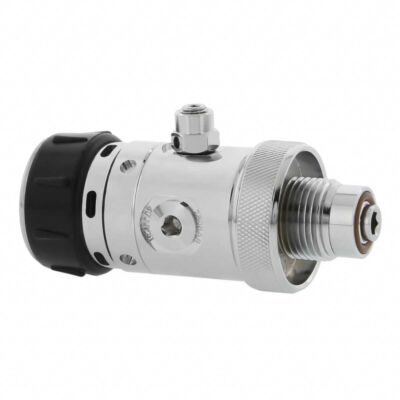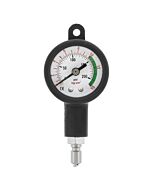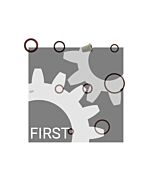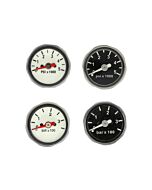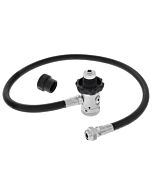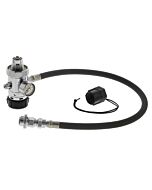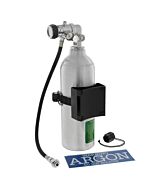DGX Gears FIRST Regulator w/OPV
- BSP G5/8 DIN connector compatible with 200 Bar and 300 Bar valves
- Classic balanced piston first stage
- Measures {4.0 in x 1.5 in | 10.2 cm x 3.8 cm}l - weighs {28 oz | 0.8 kg}
- Three LP 3/8-inch ports - one HP 7/16-inch port
- Includes OPV (Over Pressure Valve)
DGX Gears FIRST Regulator w/OPV
Nitrox Ready and suitable for use with air or argon, the DGX Gears FIRST Regulator has a classic balanced downstream (aka "flow-by") piston first stage and includes an over pressurization relief valve (OPV). The value priced FIRST is perfect for inflation, pony bottle and oxygen accelerated decompression applications. This inexpensive first stage provides good performance for its design class and we have no concerns using the FIRST regulator for recreational sport SCUBA diving depth applications. The FIRST is popular for reliability and minimal maintenance in dive shop rental fleets. However, we do not recommend the FIRST for breathing use in extended range depths or in very cold waters.
Measuring {4.0 in x 1.5 in | 10.2 cm x 3.8 cm}, the regulator offers three standard size low pressure 3/8-inch ports (one is used by the OPV), one standard size high pressure 7/16-inch port. This regulator has the typical BSP G5/8 DIN connector that will fit 200 Bar and 300 Bar valves.The FIRST is proven exceptionally reliable and does not have a recommended periodic maintenance interval but we suggest checking for signs of wear after each cycle of 50 to 100 dives by measuring and evaluating intermediate pressure (IP). We believe our customers have the right-to-repair, so we publish a detailed service manual and we sell without restriction all service parts. See the Product Attachments tab for the service manual including IPB and torque values.
On dedicated inflation systems or on breathing systems where the second stage has a flow stop cut-off installed, there is no regulator second stage to provide relief should the high pressure seat begin to fail and the intermediate output pressure rise. Without a way to relieve the pressure, the device could begin inflating rapidly or the low pressure hose could rupture. Best practice in such configurations is to include the over-pressure relief valve to provide the same relief function as a regulator second stage. If you configure the FIRST with a downstream second stage, then the OPV is unnecessary and may be removed if you wish.
| Brand | DGX Gears |
|---|---|
| SKU | DX-701022A |
| Weight | 1.750000 |
Customer Reviews
YOU MAY ALSO BE INTERESTED IN THE FOLLOWING PRODUCT(S)
SCUBA Regulator Service Frequency
Many dive shops recommend servicing every year, while many manufacturers recommend servicing every 2 years or 100 dives. The difference is explained by the history of recreational diving equipment. In the early days of diving, the wear components (primarily the o-rings & seats) and lubricants were of a quality that most manufacturers recommended annual service. The labor cost of service and the material cost of a few soft parts was such that this was a reasonable course of action. More recently, materials have improved considerably (the industry has switched to fluorocarbon based synthetic elastomers and lubricants as a result of widespread adoption of oxygen enriched Nitrox) plus labor and material costs have skyrocketed. Today, it wouldn't be unusual for the cost of two or three overhauls to approach the cost of a new regulator.
In the past few years many regulator manufacturers have adopted the every 2 years or 100 dives recommended service period. A few manufacturers have switched to recommending an "inspection only" every other year and a complete service every 2 years or 100 dives. A very few manufacturers have not yet updated their service recommendations and still specify annual overhauls in deference to their retailers. Dive shops that have service departments often retain the very conservative annual service recommendation regardless of manufacturer policies. Some experienced divers perform a periodic inspection themselves and do not service their regulator until it exhibits signs of wear (typically an unstable first stage IP or a dribbling second stage), which means their regulators often go for many years between overhauls. Thus the answer that service frequency seems to be more a matter of opinion and experience than science and research.
